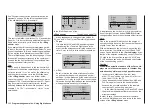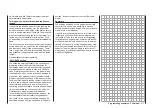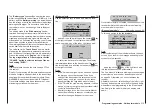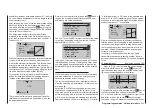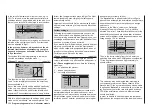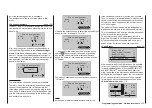
318 Programming examples - Helicopter models
Helicopter models
With this programming example, you must have al-
ready covered the description of the individual menus
and you must be familiar with the use of the transmit-
ter. In addition, the helicopter’s mechanical construc-
tion should correspond exactly to the corresponding
manual. The electronic capabilities of the transmitter
should by no means be used to straighten out rough
mechanical imprecision.
As is often the case in life, there are also various
ways and possibilities to achieve a specific goal when
programming the
mc-16
HoTT or
mc-20
HoTT
transmitter. The following example should provide you
with a clearer structure for logical programming. If
there are multiple possibilities, the simplest and most
clearly arranged solutions are recommended first.
In order for the helicopter to function faultlessly later
on, you are, of course, free to try out other solutions
which may be better for you.
The programming example is based on the clockwise-
rotating STARLET 50 helicopter from Graupner with
three pivot points each offset 120 ° of the swashplate
type “3Sv(2 Roll)”, beginner adjustment without in-
creased throttle curve; without heading-lock gyro sys-
tem and without transmitter-side gyro influence of the
“normal operating mode” and without speed regulator.
This simple program was also consciously selected
to demonstrate that a helicopter which flies really well
can also be attained with relatively little (program-
ming) effort.
However, we do not want to dispense entirely with the
enhancement possibilities: Therefore, after the basic
description, you will find adjustment information for
the gyro effect, the speed regulators and for the flight-
phase programming.
Note:
If you are not interested in the combustion helicop-
ter described here, but a electric helicopter, please
continue reading anyhow! With the exception of the
omitted idle settings, you can practically adopt most
of the settings described in the following unchanged.
In the scope of the initial commissioning of a new
transmitter, in the selection menu …
»Basic settings«
Battery type
Battery warning
Touch Sense
Top LCD Contrast
Lith.
Display light
Region
2
3.60V
0
Euro
unlim.
Basic settings
Vario Vol
Beeps Vol
Power-on beep
yes
Power on warn.
unlim
BT Headset
OFF
0/0
ID PAIR
OFF
BT Volume
8
Voice Vol
–––
5
–––
7
–––
7
Own
Stick mode
1
Modulation
HoTT
DSC Output
PPM10
Pitch min
back
Bottom LCD Contr.
0
SEL SEL
fr
fr
fr
… some basic information should be entered. This
serves various purposes:
The first three lines of this menu can be used to
individually regulate, in increments between 0 and 10,
the volume of voice and signal output emitted via the
built-in loudspeakers or the transmitter’s headset con-
nector. The fourth line of this menu is used to record
the transmitter owner’s name. Select the characters
for this from an extensive character list on the second
display screen, which can be reached via the
symbol with a brief tap on the center
SET
key of the
right touch pad:
! " # $ % & ’ ( ) � + , – . / 0 1 2 3
4 5 6 7 8 9 : ;
Owner H-J Sand
b
F G H I J K L M N O P Q R S T U V W X
Y Z [ ¥ ] ^ _ ` a
b
c d e f g h i j k
? @ A B C D E
The pre-set for “Stick mode” can be selected accord-
ing to the criteria described on page 269.
The same applies to the pre-sets for “Modulation”
and “DSC Output”, page 270.
The pre-set for “Pitch min” is a matter of personal
control habits, page 109.
The pre-sets established here for “Stick mode”,
“Modulation”, “DSC Output” and “Pitch forward/
back” will be initially adopted when a new model
memory is created but they can also be freely
changed within a given model memory location to any
other available option.
The settings in the “Top/Bottom LCD Contrast” lines
determine the legibility of the given displays under
poor light conditions and the setting in the “Display
light” line determines how long display lighting re-
mains illuminated after the transmitter is switched on
without any actuation of a control afterward or after
the last control actuation.
The selection of “yes/no” in the “Power-on beep”
line determines whether the “recognition melody” is
to sound when the transmitter is switched off or on
again.
Summary of Contents for HoTT MC-16 Series
Page 1: ...Programming Manual mc 16 mc 20 HoTT 1 en mc 16 mc 20...
Page 27: ...27 For your notes...
Page 53: ...53 For your notes...
Page 61: ...61 For your notes...
Page 65: ...65 For your notes...
Page 71: ...71 For your notes...
Page 103: ...103 For your notes...
Page 107: ...107 For your notes...
Page 111: ...111 For your notes...
Page 155: ...155 For your notes...
Page 165: ...165 For your notes...
Page 201: ...201 For your notes...
Page 229: ...229 For your notes...
Page 231: ...231 For your notes...
Page 261: ...261 For your notes...
Page 265: ...265 For your notes...
Page 301: ...301 For your notes...
Page 327: ...327 For your notes...
Page 328: ...328 For your notes...



